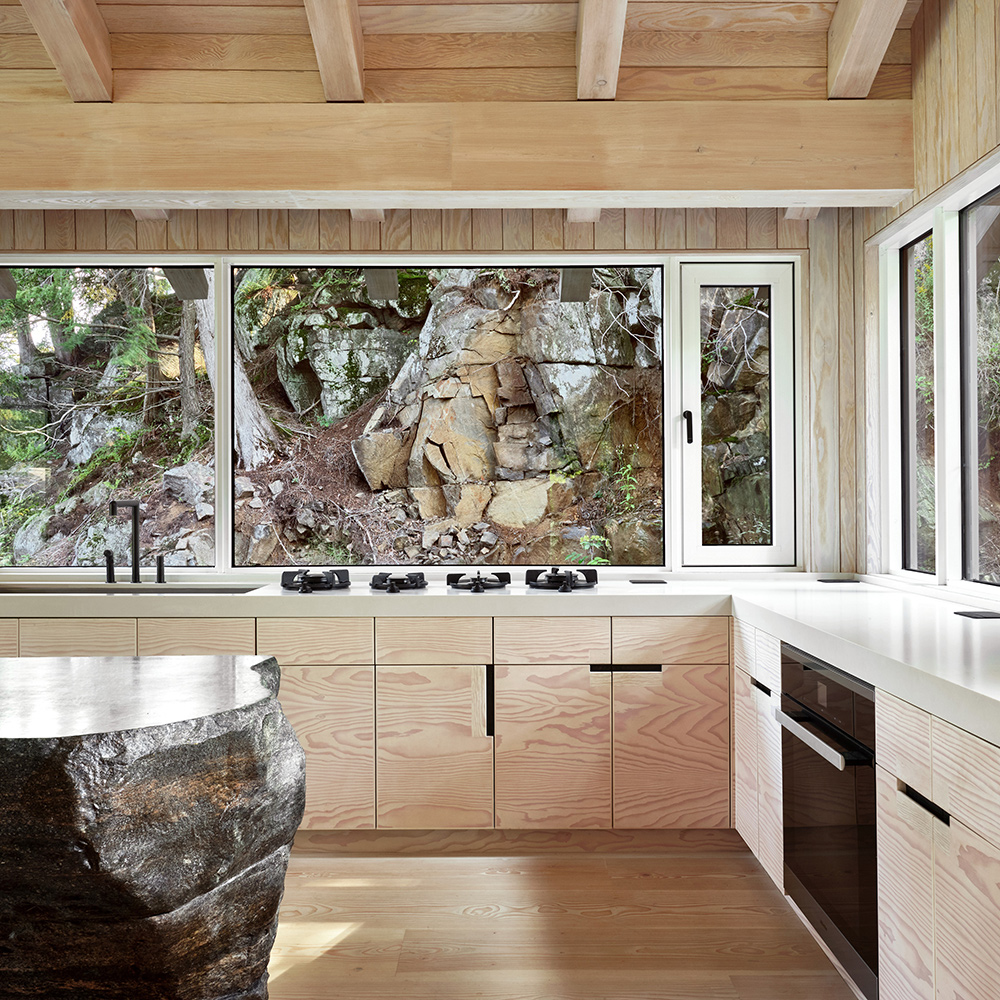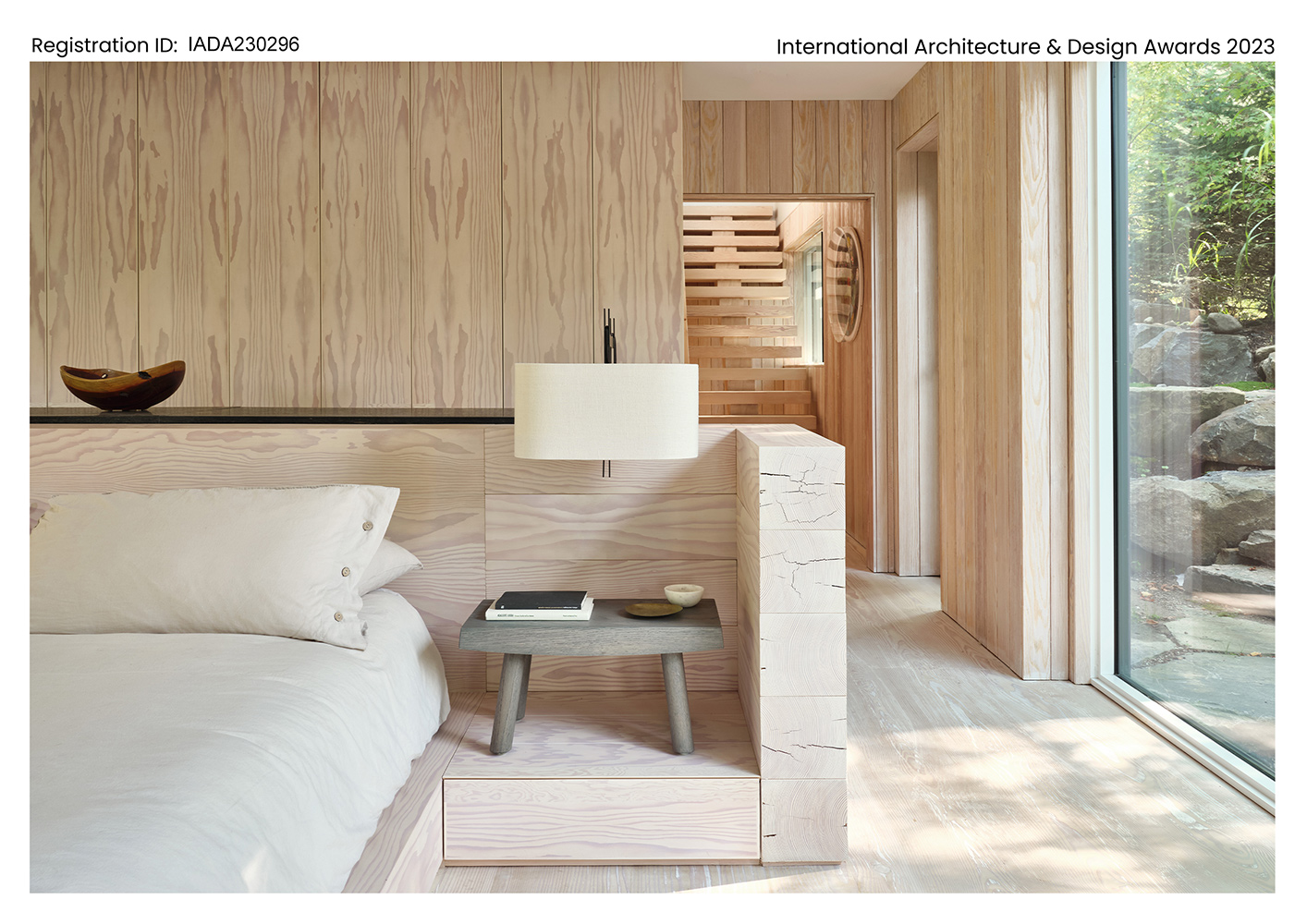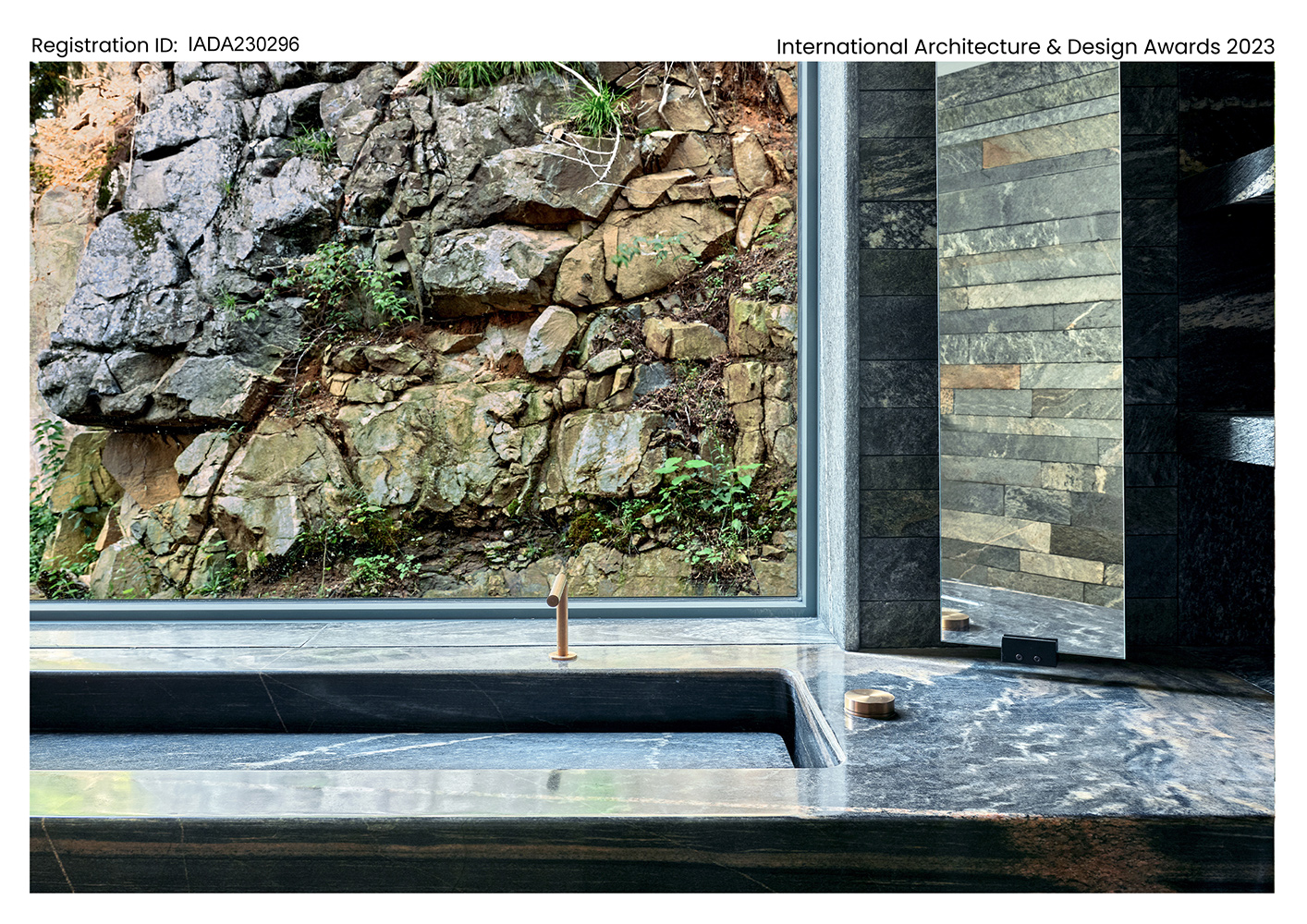Platinum Winner of the International Architecture & Design Awards 2023
Architect / Designer:
Studio Paolo Ferrari
Studio:
Studio Paolo Ferrari
Copyright:
Joel Esposito
Country:
Canada
Muskoka Lake House, a retreat overlooking Lake Rosseau, part of a network of freshwater bodies adjacent to Georgian Bay, Ontario whose rocky coastline has inspired some of Canada’s most iconic painters. We wanted to create a place of respite from the intensity of city life and also to build as sensitively as we could, complementing, but never overwhelming, the surrounding environment.
The building plan was deliberately simple—a pitched roof, an upper-level great room, and sleeping quarters below. We limited ourselves to two primary materials: granite, which we used for the hefty kitchen island and the carved sinks in the bathroom, and whitewashed Douglas fir, which appears in the ceilings, the millwork, and the wall cladding. The granite is coarse grained and hard. It references the minerality of the site and imbues the interiors with a sense of ruggedness. The Douglas fir offers tactility and warmth, and it connects the house with vernacular building traditions. We sourced both materials locally, sometimes extracting them from the property itself. The only imported product was the flooring made of limed Douglas fir, a centuries-old material beloved for its plank size and quality, which we got from a company in Denmark.
Our guiding ethos was warm minimalism—the interiors derive their elegance from a lack of visual clutter—but we also focused on balance. Light juxtaposes darkness: the principal bedroom is awash in sunlight, while the en suite is deep and cavernous. Refined details coexist alongside rough surfaces, a nod to the Japanese design tradition of wabi-sabi. The kitchen island, for instance—a large, unfinished block of granite—evokes the boulders and outcroppings one sees across the Canadian Shield, an expanse of bedrock that extends from the Great Lakes to the Arctic Coast. With its size and monumentality, the island offsets the expertly crafted cabinetry that surrounds it. We custom designed all the built-ins and furnishings: the principal bed, constructed of stacked Douglas fir; the double-sided fireplace, which anchors the living room; and the exterior rock garden, reminiscent of a Japanese onsen (or hot spring), which has a sauna and outdoor shower.
Always, architecture defers to nature. Windows frame views in all directions, not only outward to the lake but also inward to the granite escarpment, which is every bit as exquisite as the dappled water. When walking through the house—passing from the entranceway to the great room, or from the dimly lit downstairs hallway to the sundrenched bedrooms—one feels that one is journeying through an inlet in a rockface and emerging, dramatically, into sunlight.
In the en suite bathroom, the mirrors on either side of the sink have custom pivots, so they can be easily rotated out of the way, allowing unobstructed views onto the rock. This is a small detail but one that matters to us. In a building so fully immersed in its environment, vanity itself becomes an afterthought. Stillness, space, connection to nature—these are the best and most rarified luxuries imaginable.
Muskoka Lake House, a retreat overlooking Lake Rosseau, part of a network of freshwater bodies adjacent to Georgian Bay, Ontario whose rocky coastline has inspired some of Canada’s most iconic painters. We wanted to create a place of respite from the intensity of city life and also to build as sensitively as we could, complementing, but never overwhelming, the surrounding environment.
The building plan was deliberately simple—a pitched roof, an upper-level great room, and sleeping quarters below. We limited ourselves to two primary materials: granite, which we used for the hefty kitchen island and the carved sinks in the bathroom, and whitewashed Douglas fir, which appears in the ceilings, the millwork, and the wall cladding. The granite is coarse grained and hard. It references the minerality of the site and imbues the interiors with a sense of ruggedness. The Douglas fir offers tactility and warmth, and it connects the house with vernacular building traditions. We sourced both materials locally, sometimes extracting them from the property itself. The only imported product was the flooring made of limed Douglas fir, a centuries-old material beloved for its plank size and quality, which we got from a company in Denmark.
Our guiding ethos was warm minimalism—the interiors derive their elegance from a lack of visual clutter—but we also focused on balance. Light juxtaposes darkness: the principal bedroom is awash in sunlight, while the en suite is deep and cavernous. Refined details coexist alongside rough surfaces, a nod to the Japanese design tradition of wabi-sabi. The kitchen island, for instance—a large, unfinished block of granite—evokes the boulders and outcroppings one sees across the Canadian Shield, an expanse of bedrock that extends from the Great Lakes to the Arctic Coast. With its size and monumentality, the island offsets the expertly crafted cabinetry that surrounds it. We custom designed all the built-ins and furnishings: the principal bed, constructed of stacked Douglas fir; the double-sided fireplace, which anchors the living room; and the exterior rock garden, reminiscent of a Japanese onsen (or hot spring), which has a sauna and outdoor shower.
Always, architecture defers to nature. Windows frame views in all directions, not only outward to the lake but also inward to the granite escarpment, which is every bit as exquisite as the dappled water. When walking through the house—passing from the entranceway to the great room, or from the dimly lit downstairs hallway to the sundrenched bedrooms—one feels that one is journeying through an inlet in a rockface and emerging, dramatically, into sunlight.
In the en suite bathroom, the mirrors on either side of the sink have custom pivots, so they can be easily rotated out of the way, allowing unobstructed views onto the rock. This is a small detail but one that matters to us. In a building so fully immersed in its environment, vanity itself becomes an afterthought. Stillness, space, connection to nature—these are the best and most rarified luxuries imaginable.
Studio Paolo Ferrari
Internationally recognized, Studio Paolo Ferrari is a practice at the cutting edge of international design. Today the studio works with prestige and emerging luxury brands or through private commissions on hospitality, retail, and residential projects, delivering highly considered guest experiences, through attention to detail and full immersion, into worlds both luxurious and distinct. A distinctive, vision-forward approach has defined Ferrari’s output as he continues to collaborate with industry-leading clients all over the world. With the ever-expanding presence of the digital, Studio Paolo Ferrari believes in pursuing work where experiential worlds evoke a quality of awe.







